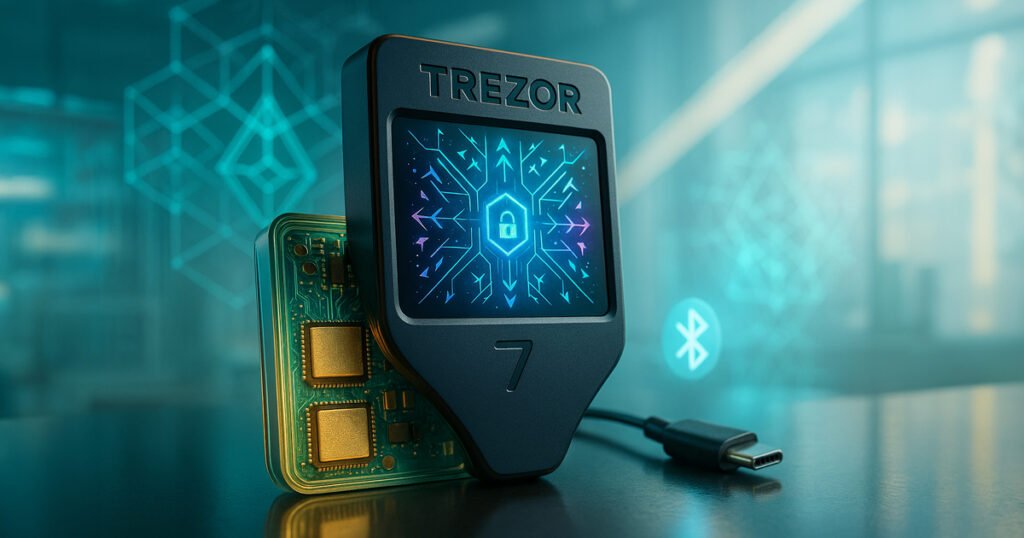Trezor Safe 7: The Quantum-Ready Cryptocurrency Wallet Set for Release
Trezor has recently made headlines with its upcoming product, the Safe 7, announced to hit the market on November 23, 2025. This new hardware wallet is being marketed as "quantum-ready," a designation that reflects its future capabilities. However, it’s essential to clarify that this readiness pertains specifically to the wallet’s ability to verify future firmware as well as device attestation utilizing post-quantum cryptography. It does not currently offer enhanced security for Bitcoin or Ethereum transactions. As the cryptocurrency landscape evolves, Trezor aims to future-proof the Safe 7 by making it adaptable and ready to integrate post-quantum security features once they become available.
Understanding Quantum Readiness in Cryptocurrency
Trezor’s Safe 7 is designed with a robust future-proofing posture. According to the company, while post-quantum upgrades for public blockchain networks are still in development, the Safe 7 is structured to accept and validate these updates when they arrive. This innovative approach extends the device’s security and reliability. The significant advantage lies in its capability to ensure authenticity throughout the transition to post-quantum algorithms without needing to swap out hardware. Users won’t find themselves boxed into outdated technology as development in the field of quantum computing progresses.
Innovative Features: TROPIC01 Chip and Secure Architecture
At the core of the Safe 7 is the TROPIC01 secure chip, which sets a new standard for transparency in hardware wallets. Unlike conventional secure elements that function as closed-off black boxes, TROPIC01 allows for external audits, facilitating a more transparent approach to security. Coupled with a second certified secure element, Trezor aims for diversified storage solutions and enhanced tamper resistance. This layered storage model is essential in our current threat landscape, where hardware wallet vulnerabilities are increasingly linked to user endpoints, firmware, and recovery procedures.
Connectivity Enhancements: Bluetooth and USB Modes
The Safe 7 also introduces a significant improvement in connectivity options. For enhanced user experience, it incorporates Bluetooth capabilities for mobile phone interactions. The communications will run through a secure mechanism called the Trezor Host Protocol, enabling encrypted, authenticated, and integral host-to-device messaging. For users uninterested in wireless interfaces, Bluetooth connectivity will not be mandatory; they can opt for a USB-only mode, providing flexibility for varied usage contexts and enhancing overall security compliance.
Navigating Current Cryptography Limitations
Trezor emphasizes that the Safe 7 does not alter how public blockchains like Bitcoin and Ethereum validate transactions. Currently, these networks still depend on standards like ECDSA and Schnorr signatures. As the landscape shifts toward post-quantum cryptography, any transitions would necessitate comprehensive updates at the network level. Trezor’s focus remains firmly on allowing users to verify and trust updates related to post-quantum algorithms, meaning their hardware won’t become a hindrance during significant transitions in cryptocurrency validation.
Security and Regulatory Context: Preparing for Future Risks
The urgency for advanced wallet security has never been greater, evidenced by the staggering $2.17 billion reported stolen from cryptocurrency wallets by mid-2025, as per Chainalysis data. This dynamic increases focus on device-level protections. As regulatory bodies like the U.S. National Institute of Standards and Technology finalize post-quantum standards—such as FIPS 203 for CRYSTALS-Kyber—the market is gradually moving toward a post-quantum future. Trezor’s Safe 7 positions itself within this context, ensuring users can gradually adopt stronger security measures without losing compatibility with existing systems.
Conclusion: Is Safe 7 Worth the Upgrade?
As November 2025 approaches, users interested in upgrading to the Safe 7 will need to weigh its advantages. For crypto holders looking for hardware that can authenticate future firmware and support important security updates, Safe 7 offers a compelling proposition. However, those satisfied with their current wallets may choose to wait until network post-quantum developments are firmly in place. Noticing that current blockchain signatures remain unchanged, potential buyers should calibrate their expectations for the immediate capabilities of the Safe 7. Ultimately, the Safe 7 serves as a beacon of adaptability and preparedness for the evolving landscape of cryptocurrency, making it a noteworthy addition to the market.


